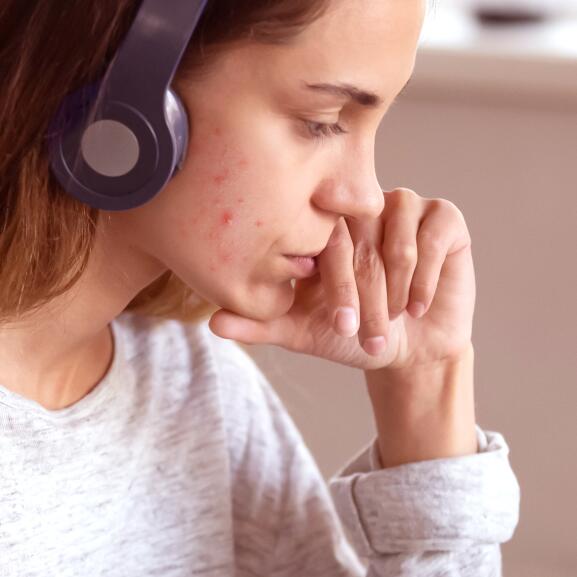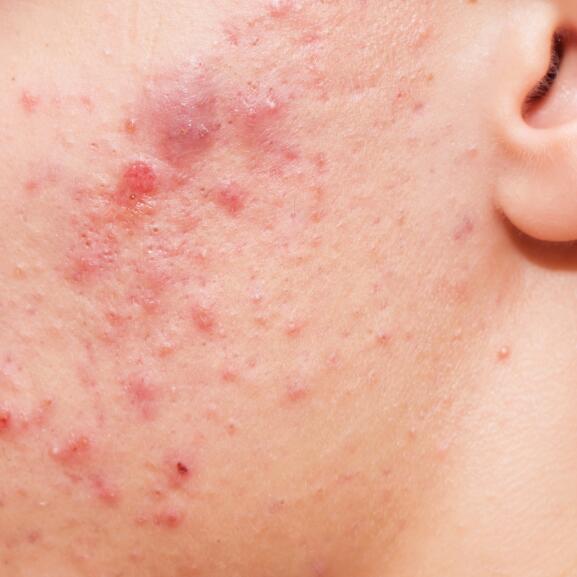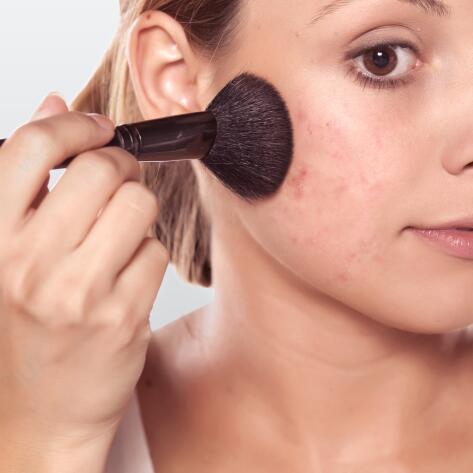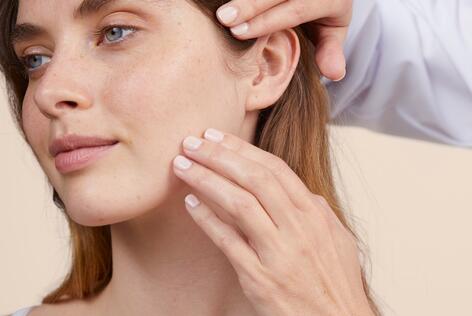Recognising inflammatory acne
Recognising inflammatory acne
Large, hard, red pimples, with or without a white head. This is how acne presents itself in its inflammatory phase. How can it be treated? Is it possible to camouflage it? Here are some tips.

What is inflammatory acne?
Inflammatory acne usually follows retentional acne, which manifests itself as blackheads or microcysts. These are the result of the overproduction and thickening of sebum, which cannot flow through the pores of the skin. This closed environment encourages the proliferation of the bacteria Cutibacterium Acnes.
Microcysts and open comedones (blackheads) can either disappear spontaneously or become inflamed. The pimples then take the form of papules (large, hard, red pimples) and pustules (pimples with a white head containing a purulent liquid), or even nodules when the inflammation is deep. This is inflammatory acne.
Inflammatory acne affects teenagers...
and women
In teenagers
Inflammatory acne is most often linked to the hormonal upheaval of puberty. It appears where the sebaceous glands are most numerous: on the face, back, shoulders and upper chest.
In women
This type of acne can also occur in adulthood, mainly in women. It tends to be located in the lower part of the face: along the jaw line and on the chin. Here too, the origin of this acne can be hormonal, but other factors come into play such as diet, stress or the use of unsuitable cosmetic products.
How do I take care of my acne-prone skin?
Inflammatory acne can be treated with medication prescribed by a general practitioner, a paediatrician or a dermatologist, the skin specialist. Your daily skin care routine is also very important.
Your objective: to rid your skin of impurities (sebum, make-up, pollution, etc.) and reduce imperfections. Rinse-off cleansing gel, micellar water to be applied with a cotton pad, gentle cleansing cream (if your skin is dried out by a treatment)... The choice is yours. And above all: do this cleansing morning and evening. For greater effectiveness and to soothe your skin, don't hesitate to spray thermal water on your face after cleansing.
You can now apply your local treatment, your anti-blemish care or your mattifying care. If your skin is oily, choose a light, non-greasy emulsion containing absorbent microcapsules to moisturise and mattify your skin. If your skin is dry due to an anti-acne treatment, choose a soothing and nourishing cream. Your cream should be non-comedogenic and formulated for blemished skin.

FRIENDLY (AND EXPERT) ADVICE
It’s true that the sun improves the appearance of inflammatory acne. But beware of the rebound effect!
When exposed to the sun, the skin thickens under the effect of ultraviolet rays and the pimples seem to disappear. But this is only temporary. As soon as the sun's rays diminish, the skin regains its usual thickness and the pimples return in force. This is called the rebound effect.
The first piece of advice to avoid this is to limit exposure to the sun as much as possible. When this is not possible, systematically apply a sun care product for oily skin with imperfections under your day care. This should offer high protection (SPF 50+) and a broad UVA-UVB spectrum. With their non-greasy texture, some of these suncare products allow you to combine high protection with a bare skin feel. They are particularly suitable for oily skin.
The right gestures to camouflage inflammatory acne
Can you wear make-up if you have inflammatory acne? The answer is yes! As long as you avoid touching your pimples as much as possible and choose non-comedogenic products that are adapted to your skin, otherwise your acne could flare up even more. To mask imperfections without causing the appearance of new pimples, the safest thing to do is to choose medical corrective make-up specially formulated for your skin type.
The must-have: a yellow corrector stick if the pimples are purplish, or a green one if they are rather red; a compact complexion cream with a matte finish for very good coverage without a mask-like effect; and a translucent mosaic powder to set the make-up and mattify the skin.

Our solutions for taking care of inflammatory acne
Eau Thermale Avène skincare products designed to reconcile you with your skin
- Avène Thermal Spring Water Spray
Thermal Spring Water
Avène Thermal Spring Water SpraySoothes - Restores the skin barrier - Calms
NEWSLETTER
We’re always here for your skin!
All our tips for taking care of your skin day to day.

Which skin care routine should you adopt?
Identify what it really needs with the help of our experts and discover the most suitable skin care routine for you.

